
Website owner: James Miller
Six simple force-multiplying devices - the simple machines. Lever, pulley, wheel and axle, inclined plane, screw, wedge.
There are six simple force-multiplying devices that are employed in various forms in many ways in our mechanized society and are important components of many machines. They are
(1) the lever
(2) the pulley system (i.e. block and tackle)
(3) the wheel and axle
(4) the inclined plane
(5) the screw
(6) the wedge
Many machines are either modifications of one of these devices or combinations of two or more of them. In physics these six devices are called the simple machines.
In all of the above machines there is a force F1 applied to the machine which moves through some distance s1 and a force F2 exerted by the machine on the load which moves through some distance s2. The product F1s1 represents work put into the machine. The product F2s2 represents useful work done by the machine.
Input and output of a machine. The work W1 = F1s1 representing work input into the machine is called the input. The work W2 = F2s2 representing work output by the machine is called the output.
In a frictionless machine W2 = W1 and F2s2 = F1s1. In this ideal case, where no friction is assumed, we have

Mechanical advantage. The actual mechanical advantage (AMA) of a machine is
AMA = F2 /F1
Thus if an applied force of 1 lb generates a multiplied force of 5 lb, the actual mechanical advantage of the machine is 5.
The ideal mechanical advantage (IMA) of a machine is the mechanical advantage it would have if there were no friction and is given by
IMA = s1/s2
However, there is usually friction. Consequently, of the work input into the machine, some is lost to friction. Thus
W1 = Wf + W2
where Wf is work done against friction, or
F1s1 = Wf + F2s2
Efficiency of a machine. The efficiency E of a machine is given by


The lever. A lever consists of a rigid bar which is free to turn about a fixed pivot point called a fulcrum. The lever can be used to multiply force and lift weights. The part of the lever between the load and fulcrum is called the load arm. The part between the effort and fulcrum is called the effort arm. See Fig. 1.
The effort needed to lift a load is given by the law of the lever:
Law of the lever: The effort times the length of the effort arm is equal to the load times the length of the load arm.
This law corresponds to the rule that for equilibrium (i.e. balance) the sum of the counterclockwise moments about the pivot point must be equal to the sum of the clockwise moments.
Example. What force F is needed to lift a load of 100 lb if the length of the load arm is 2 ft and the length of the effort arm is 10 ft?
Solution. 10F = 2×100 so F = 20 lb
Mechanical advantage of a lever. The mechanical advantage of a lever is given by


---------------------------------------------
Proof. In Fig. 2 an applied force F1 at point A causes a multiplied up-acting force at point B, lifting the load. In doing this, point A moves through a distance s1 along arc AC to point C while point B moves a distance s2 along arc BD to point D. The ideal mechanical advantage of this machine is then
IMA = s1/s2
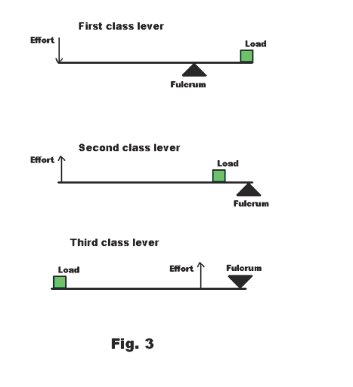
where s1 is the length of arc AC and s2 is the length of arc BD. However, s1/s2 = AO/OB. Why? Because arcs of circles subtended by equal central angles are directly proportional to the radii of the circles. Thus IMA = AO/OB. The efficiency of levers is often nearly 100%.
---------------------------------------------
Three classes of levers. There are three classes of levers.
1. First class lever. In a first class lever the fulcrum is located between the effort and the load.
2. Second class lever. In a second class lever the load is located between the fulcrum and the effort. Example: wheelbarrow.
3. Third class lever. In a third class lever the effort is located between the fulcrum and the load. Example: forearm. A third class lever multiplies speed rather than force.
See Fig. 3.
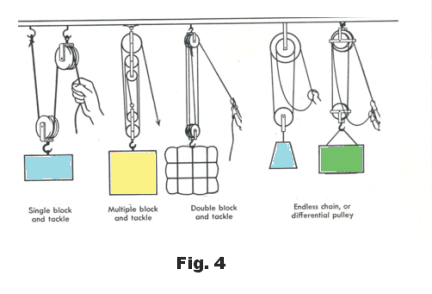
The pulley system (block and tackle). There are a variety of pulley systems that can be used for lifting loads. Pulleys are mounted in frames called blocks. The rope is called tackle.
The ideal mechanical advantage of a pulley system can be computed from the formula
IMA = s1/s2
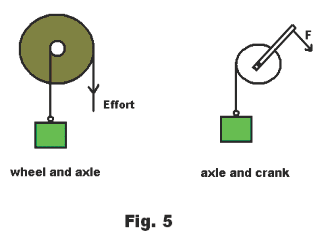
where s1 is the distance through which the applied force travels and s2 is the distance through which the load travels. In multiple block and tackle the IMA is equal to the number of ropes supporting the load. Because of friction in the blocks and rigidity of the ropes the efficiency of block and tackle is usually less than 60%.
The wheel and axle. The wheel and axle consists of a wheel or crank that is rigidly attached to an axle. See Fig. 5. In Fig. 6 we see that a wheel and axle is similar to a lever with unequal arms.
The ideal mechanical advantage of the wheel and axle is
![]()
where
R = radius of the wheel
r = radius of the axle
The wheel and axle is often used to multiply speed instead of force. Example: wheels on bicycles and motor vehicles.
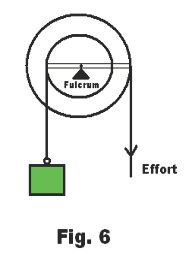
The inclined plane. When it is desired to raise something that is too heavy to lift, an inclined plane or ramp is sometimes used. One may load heavy barrels on a truck by rolling them up an inclined plane constructed of planks.
The ideal mechanical advantage of an inclined plane is
![]()
where
l = length of the plane (length of incline)
h = height of plane
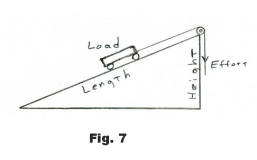
See Fig. 7.
The screw. A screw is really an inclined plane wound on a cylinder. The distance between the threads is called the pitch of the screw. One complete revolution of the screw will move it into an object the distance of the pitch. Wood screws, bolts, and screw jacks represent applications of the screw.
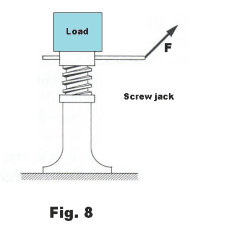
The mechanical advantage of a screw depends on the length of the lever arm used in turning the screw. See Fig. 8. While the effort force completes a full circle, the head and axis of the screw make one complete turn and the load moves a distance equal to the pitch of the screw. If r is the length of the lever arm, then in one complete revolution, the distance s1 through which F moves is 2πr. As F moves this distance, the weight w moves the distance d, which is the pitch of the screw. Thus the ideal mechanical advantage is given by
![]()
where
r = length of lever arm
d = pitch of screw
The wedge. The wedge is really a double inclined plane. There is so much friction in using a wedge that a theoretical mechanical advantage has no significance. A long thin wedge is easier to drive than a short thick one so one can say that the mechanical advantage of a wedge depends on the ratio of its length to its thickness. Examples of wedges: axes, nails, pins.
References
Dull, Metcalfe, Brooks. Modern Physics.
Schaum. College Physics.
Sears, Zemansky. University Physics.
Jesus Christ and His Teachings
Way of enlightenment, wisdom, and understanding
America, a corrupt, depraved, shameless country
On integrity and the lack of it
The test of a person's Christianity is what he is
Ninety five percent of the problems that most people have come from personal foolishness
Liberalism, socialism and the modern welfare state
The desire to harm, a motivation for conduct
On Self-sufficient Country Living, Homesteading
Topically Arranged Proverbs, Precepts, Quotations. Common Sayings. Poor Richard's Almanac.
Theory on the Formation of Character
People are like radio tuners --- they pick out and listen to one wavelength and ignore the rest
Cause of Character Traits --- According to Aristotle
We are what we eat --- living under the discipline of a diet
Avoiding problems and trouble in life
Role of habit in formation of character
Personal attributes of the true Christian
What determines a person's character?
Love of God and love of virtue are closely united
Intellectual disparities among people and the power in good habits
Tools of Satan. Tactics and Tricks used by the Devil.
The Natural Way -- The Unnatural Way
Wisdom, Reason and Virtue are closely related
Knowledge is one thing, wisdom is another
My views on Christianity in America
The most important thing in life is understanding
We are all examples --- for good or for bad
Television --- spiritual poison
The Prime Mover that decides "What We Are"
Where do our outlooks, attitudes and values come from?
Sin is serious business. The punishment for it is real. Hell is real.
Self-imposed discipline and regimentation
Achieving happiness in life --- a matter of the right strategies
Self-control, self-restraint, self-discipline basic to so much in life